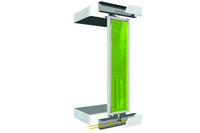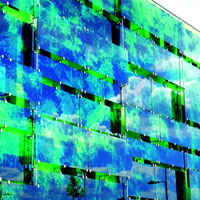Green facades in vogue
Energy efficiency and conservation belong to the most important tasks in combating global warming. Buildings alone take up 40 percent of the total power consumption. As a crossing point between indoors and outdoors, the facade plays a significant role in the definition of a building’s energy efficiency.
| Green facade or an energy efficient façade in the most basic terms of reference is a building envelope which reduces the heat gain by the building and helps maintain comfortable thermal and visual conditions inside, thereby reducing the need for mechanical air conditioning and artificial lighting. To make a building energy efficient, the Heat, Ventilation, Air Conditioning (HVAC) equipment and system sizing is largely dependent on heat flow through the facade. If a façade system helps the building with less heat gain, the air conditioning system uses less energy in order to cool the |
 |
building down. Therefore an energy efficient façade calls for a high thermal performance. To have an energy efficient facade, the construction materials used and their insulation abilities must be considered.
While the carbon footprint of a building may be one parameter, the measurement of the embodied energy used to construct and run the building may be a better indicator. With mechanical ventilation, lighting and electrical appliances forming a significant part of a building’s energy use, an energy efficient façade can achieve tremendous savings for the owner.
Innovation in glass
In tropical countries like India, natural light is a glare, whereas in parts of the western world where glass is used to reduce energy use for lighting. The contemporary buildings usually have glass as facades. The use of glass in the south and west facades of a building will be bad in terms of thermal transfer. The use glazed or tinted glass, where 50 per cent of solar heat gets reflected off the surface, 65 per cent of the visible light is transmitted into the building.
“Frankly, understanding on the energy efficient façade is no rocket science and we have been doing these since time immemorial. But change in our lifestyle and building aesthetics has left us in a fix. Glass buildings which are swiftly filling up our skylines are anything but green. Glass has its function in the building but the current obsession with it is bordering madness and illogical. Glass-houses as we had studied in our school textbooks traps heat inside and makes the interior hotter, something which is needed in cold climates of Europe but is not a desirable thing in tropical heat of India,” Mr. Avikal Somvanshi, Research Associate, Sustainable Building Programme, Centre for Science and Environment (CSE). CSE is a public interest research and advocacy organisation, which researches into, lobbies for and communicates the urgency of development that is both sustainable and equitable. It has a Sustainable Building Programme that works towards increasing awareness about good building practices which help reduce the energy and water footprint of buildings.
| With such an impetus on energy efficiency, the industry has been pushing for energy efficient glass, double-triple glazed, tinned, vacuum filled and many other varieties. “Builders today are using high-end glass to define green facade, and in my opinion this is an erroneous approach. More glass allows more daylight is a myth; in India the sun is so harsh that it gives glare not comfortable light. We have been hunting for ways to reduce the sunlight entering our buildings forever, even today if you go into any of these swanky glass buildings everyone has binds and curtains drawn most of the time, than what is the point of having so much lighting coming in,” adds Mr. Avikal. Using a lesser toxic version of |
 |
something to improve the health cannot justify its use to start with. Buildings should have facades which let it breathe, allowing cross-ventilation, while cutting down direct sun via sunshades and properly insulated walls, that is the true green facade.
Even the mid-range performing glass with an external sunshade to lower the heat gain into the building can be useful. A cooler façade can be termed less energy that the HVAC system will require to use to cool the building. This also helps with the re-radiation of human heat and appliances such as computers within the building.
Opaque surface can be an ideal situation for an energy efficient façade or cladding unless it is used as white or lighter colour with 100 percent shiny level. Using heat reflecting paints is another trend catching up to achieve green facades. This paint technology helps reflect the infrared light from the coated surface, which means less heat being absorbed into the building. A similar type of paint can also be applied to metal panels as well, and can offer a cost and energy-efficient solution to heavy insulation for solid walls.
Non-glass materials used for green facade
The advancement in technology has paved the way to come out with energy efficient coatings, incorporation of thermal breaks and heat reducing paints. The reduced embodied energy then takes on a more prominent aspect of the energy efficient façade. In facades, when floor-to-floor height glass is used, the amount of heat gain will be high. Hence, by selecting glass with low-emissivity coatings help to reduce the energy used to cool the building. The latter partially block infra-red radiation (heat) while allowing visible light into the building.
Using Aluminum frames in facades is unavoidable and metal being good conductor of heat can contribute to heat gain. When a thermally-broken system is adopted, the effect can be minimized. A thermally-broken system would use gaskets or a polyamide strips within the metal framing to cut down thermal conductivity of the frames. To have an energy efficient façade, industry can also look at using recycled or recyclable materials where possible. Materials such as steel, aluminum, glass, concrete and even plastics, can contribute to lowering the energy used in its manufacturing process. For example, recycled aluminum requires only five percent of the energy used to produce aluminum from iron ore.
The design and fabrication stage of facades itself can help save energy through a quick and educated selection of materials. This may comprise not only the design and fabrication of the material itself but also the design and fabrication of the façade that makes it energy efficient. For example, it is required to take into consideration those standardadised panel modulations of materials such as glass or aluminum that reduce wastage and optimise the façade design consequently. If a glass panel is of a typical modulation the need to increase any structure or produce additional structure to support an oversized panel is eliminated.
The manufacturing process can also use recycled energy or materials to help produce the material and one example of this is green concrete, which can be used to produce precast concrete façade panels. Green concrete can be made with reclaimed industrial materials that would otherwise be used for landfill. Recycled materials can also help to reduce C02 emissions and also enable the material itself to be recycled at the end of its life cycle. Green councils are also encouraging this aspect by offering incentives for projects that use locally sourced materials
To attain a high performing façade one should also consider using the right materials after construction and its use within the built environment. A clear indicator of that would be a building’s energy bill. By choosing materials that use energy efficient coatings, heat reducing paints, or by incorporating thermal breaks are some ways to reduce the energy consumed in a building after it has been constructed. The reduced embodied energy then takes on a more prominent aspect of the energy efficient façade as the electricity bill can measure energy savings.
Some of the most innovative facades are now integrating solar panels into the facades for it to become an energy generating façade as well. Within the facades, shading devices are designed and incorporated (both vertical and horizontal) to get in maximum diffused light with least heat component.
|
Energy efficiency of rear-ventilated facades
Green concept can be evolved by adopting a rear-ventilated façade that ideally combines heating requirements, cooling requirements for summer months and the perfect day light quality. A rear-ventilated facade technology can greatly contribute to the energy efficiency of a building.
With an easy and secure variation of insulation materials, all required thermal resistance values for new and modernised buildings can be implemented effortlessly. The option of simple and safe tolerance compensation is particularly important for construction on existing sites. Modern planning and manufacturing technologies provide excellent possibilities for the construction of creative buildings with rear-ventilated facades.
|
 |
Stringent guidelines are required
Right now there is no mandatory law which restricts the glass usage in building, and the voluntary Energy Conservation Building Code (which is slated to become compulsory for commercial buildings) gives a lee-way to have 60 per cent of building facade covered with glass. “At CSE we are pushing to reduce the percentage of glass allowed on the building envelope. We believe 20-25 per cent is ideal for most of the Indian cities, and maximum of 40 per cent should be allowed with stringent norms for efficiency of glass used,” adds Mr. Avikal.